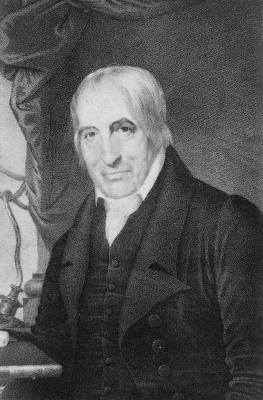President: 1809, 1810-1812
Fr. Francis Neale, S.J., served as Georgetown's sixth and eighth president in 1809 and from 1810-1812. Fr. Neale established the Georgetown Sodality but was criticized by Bishop John Carroll for his disinterest in academics.
Early Georgetown career and interim presidency
Like his brother Leonard, Francis Neale left Maryland to study abroad at the Colleges of St. Omer, Bruges, and Liège. After his ordination in 1788, Fr. Neale returned to the United States where he was initially assigned to St. Thomas Manor in Maryland. In January 13, 1792, Bishop Carroll appointed Fr. Neale pastor of the still unbuilt Trinity Chapel in Georgetown. While Fr. Neale fundraised and planned for the new chapel, he also worked at Georgetown College as a pro tempore treasurer.1
When the trustees established the first Board of Directors for Georgetown College in 1797, Fr. Neale was appointed alongside Robert Plunkett, John Ashton, Charles Sewall, and Francis Beeston. At their first meeting in October 1797, the Board of Directors appointed Fr. Neale vice president of Georgetown and gave him control over Georgetown’s finances.2 Fr. Neale remained Georgetown’s vice president for the next ten years, serving under Fr. DuBourg, his brother, Fr. Leonard Neale, and Fr. Molyneux. When Fr. Molyneux was forced to resign due to his worsening health, Fr. Neale stepped in as Georgetown’s interim president until Fr. Matthews was appointed president in February 1809. When Fr. Matthews resigned nine months later, Fr. Neale was formally appointed president on January 11, 1810.
Second presidency
One of Fr. Neale’s first and biggest contributions to Georgetown as its president was the formal organization of the first Sodality of the Blessed Virgin Mary in the United States. The Georgetown Sodality also held the first May devotions in America, which are now celebrated in almost every Cathedral and church.3
Fr. Neale also immediately reinstated the monastic schedule introduced during his brother’s presidency. While this produced a high number of vocations, overall Georgetown's enrollment decreased. In 1811, enrollment had fallen from eighty-three to fifty-six students with only nineteen of them boarding at the college.4Heightening tension between the United States and Great Britain also hurt enrollment.5 Despite this, Fr. Neale remained optimistic about Georgetown’s future and purchased an additional forty acres as a space for student amusement and recreation.6
However, Fr. Neale remained generally uninterested in leading the academic side of the college. Upon assuming the presidency, Fr. Neale redefined the position making the administration of academic affairs the obligation of the vice president, Fr. Giovanni Grassi. For the most part, Fr. Neale was an absentee president. Observing all this, Bishop Carroll lamented that Georgetown College “has sunk to the lowest degree of discredit.” 7
Fr. Neale’s term ended on September 30, 1812, and he was succeeded by Fr. Grassi.
- 1Warner, William W. “At Peace with All Their Neighbors: Catholics and Catholicism in the National Capital, 1787–1860.” Georgetown University Press. 1994. p. 20.
- 2Emmett Curran, Robert. “The Bicentennial History of Georgetown University: From Academy to University, 1789–1889.” 1993, pp.50-51.
- 3Georgetown University (Washington, DC), Ye Domesday Booke, 1939, p. 25.
- 4“The Bicentennial History of Georgetown University: From Academy to University, 1789–1889,” p. 63.
- 5“The ‘Towered Hill.’” The Hoya. Vol. 7 No.11. 11 Dec. 1925, p. 2.
- 6 Gilmary Shea, John. “Memorial of the First Century of Georgetown College, D.C.” 1891, pp. 38-39.
- 7“The Bicentennial History of Georgetown University: From Academy to University, 1789–1889,” p. 64.


